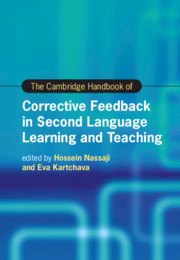Book contents
- The Cambridge Handbook of Corrective Feedback in Second Language Learning and Teaching
- Cambridge Handbooks in Language and Linguistics
- The Cambridge Handbook of Corrective Feedback in Second Language Learning and Teaching
- Copyright page
- Contents
- Figures
- Tables
- Contributors
- Acknowledgments
- Introduction Corrective Feedback in Second Language Teaching and Learning
- Part I Theoretical Perspectives on Corrective Feedback
- Part II Methodological Approaches in the Study of Corrective Feedback
- Part III Different Delivery Modes of Corrective Feedback
- Part IV Feedback Provider, Feedback Intensity, and Feedback Timing
- Part V Corrective Feedback and Language Skills
- 17 Corrective Feedback and the Development of Second Language Grammar
- 18 Corrective Feedback and the Development of Second Language Vocabulary
- 19 Effects of Corrective Feedback on Second Language Pronunciation Development
- 20 Corrective Feedback in Instructional Pragmatics
- 21 Alphabetic Print Literacy Level and Noticing Oral Corrective Feedback in SLA
- Part VI Contexts of Corrective Feedback and Their Effects
- Part VII Learners’ and Teachers’ Feedback Perspectives, Perceptions, and Preferences
- Part VIII Individual Differences, Tasks, and Other Language- and Learner-Related Factors
- Index
- References
18 - Corrective Feedback and the Development of Second Language Vocabulary
from Part V - Corrective Feedback and Language Skills
Published online by Cambridge University Press: 26 February 2021
- The Cambridge Handbook of Corrective Feedback in Second Language Learning and Teaching
- Cambridge Handbooks in Language and Linguistics
- The Cambridge Handbook of Corrective Feedback in Second Language Learning and Teaching
- Copyright page
- Contents
- Figures
- Tables
- Contributors
- Acknowledgments
- Introduction Corrective Feedback in Second Language Teaching and Learning
- Part I Theoretical Perspectives on Corrective Feedback
- Part II Methodological Approaches in the Study of Corrective Feedback
- Part III Different Delivery Modes of Corrective Feedback
- Part IV Feedback Provider, Feedback Intensity, and Feedback Timing
- Part V Corrective Feedback and Language Skills
- 17 Corrective Feedback and the Development of Second Language Grammar
- 18 Corrective Feedback and the Development of Second Language Vocabulary
- 19 Effects of Corrective Feedback on Second Language Pronunciation Development
- 20 Corrective Feedback in Instructional Pragmatics
- 21 Alphabetic Print Literacy Level and Noticing Oral Corrective Feedback in SLA
- Part VI Contexts of Corrective Feedback and Their Effects
- Part VII Learners’ and Teachers’ Feedback Perspectives, Perceptions, and Preferences
- Part VIII Individual Differences, Tasks, and Other Language- and Learner-Related Factors
- Index
- References
Summary
This chapter considers the role corrective feedback plays in second language vocabulary acquisition. The first half of the chapter considers the effects of oral corrective feedback. We first provide a classification of oral corrective feedback, and then discuss findings from existing descriptive and experimental studies, followed by pedagogical implications of the findings. Past studies have suggested that vocabulary tends to benefit more from oral corrective feedback than grammar or morphosyntax, possibly due to the high degree of noticeability and less complex abstract nature of vocabulary. The latter half of the chapter discusses the effects of written corrective feedback. After providing a classification of written corrective feedback, we present two major research frameworks: feedback-for-accuracy and feedback-for-acquisition. The chapter then presents results of experimental studies, followed by pedagogical implications of the findings. Existing studies have suggested that written corrective feedback may lead to more appropriate use of vocabulary in subsequent revisions; however, it is not yet clear whether these positive effects can be carried over to a new piece of writing. The chapter concludes with suggestions for further research and calls for more research comparing the effects of different types of corrective feedback, both oral and written, on vocabulary learning.
Keywords
- Type
- Chapter
- Information
- The Cambridge Handbook of Corrective Feedback in Second Language Learning and Teaching , pp. 387 - 406Publisher: Cambridge University PressPrint publication year: 2021
References
- 3
- Cited by

